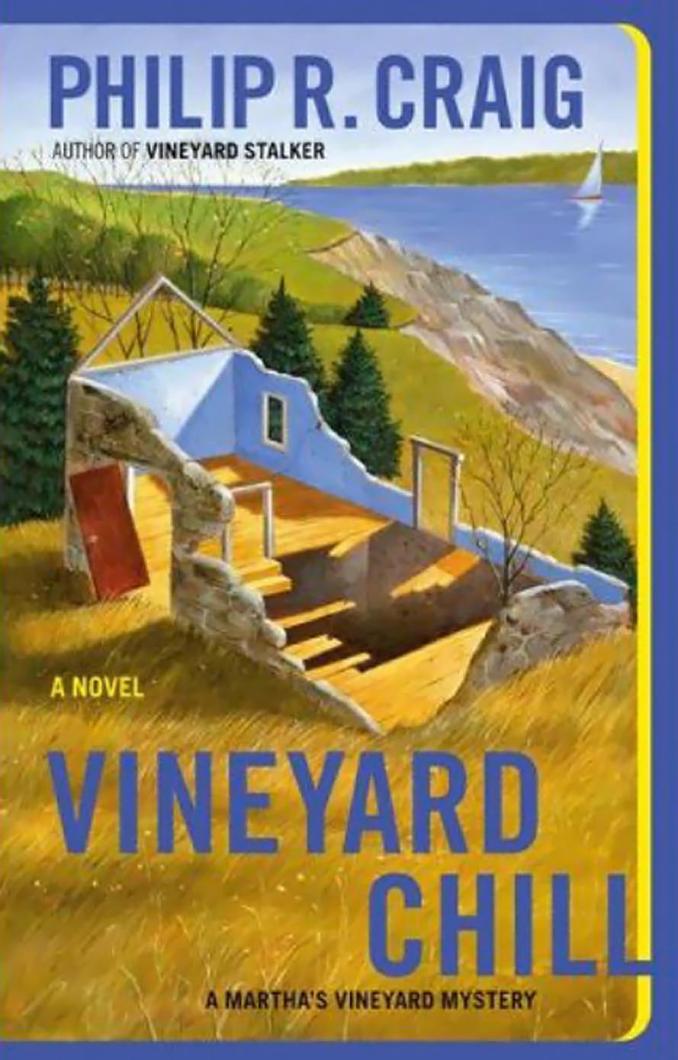VINEYARD CHILL. By Philip R. Craig. Scribner. New York, N.Y. 2008. 256 pages. $24, hardcover.
A popular young Island barmaid has gone missing. An old buddy turns up who invariably brings trouble like a perverse hostess gift. It’s winter on Martha’s Vineyard and all’s well with J.W. Jackson, wife Zee, and their two small children — if you overlook a murder or two, and a couple of thugs rolling off the ferry in a yellow Mercedes convertible in search of ill-gotten loot.
Vineyard Chill is the late Philip R. Craig’s 19th and final mystery in the much-admired J.W. Jackson series. Mr. Craig grew up on a cattle ranch near Durango, Colorado. He earned his MFA at the University of Iowa Writers’ Workshop. He died in May of 2007, attended by his wife, Shirley, and his children and grandchildren at his home in Edgartown. His penultimate mystery, Vineyard Stalker, was released two weeks after his death, so this second posthumous book seems nothing short of a miracle. Yet Susan Mercier, manager of Edgartown Books, confirms that the mystery novelist was generally a year ahead of schedule with his writing deadlines.
“I ran into him at the Harbor View Hotel over a year ago in March. He’d just finished and shipped Vineyard Chill. I bought him a Sam Adams to celebrate,” she said.
There’s a ripening and a richness to this final output that seems to flow from Craig’s “pen” — that quaint aphorism — as if author and protagonist together are fully aware of all the right moves, when to apply suspense, comic relief, character insights, and through it all, the magical mystery tour of the Island that has long been part of the Craig branding.
J.W.’s old friend, Clay Stockton, has already lured J.W. into a spot of trouble: Some 30 years before, the two youths had agreed to crew a 44- foot yawl to Freeport to pick up some unspecified cargo. In spite of the young men’s good intentions, along the line a law or two had been broken, and some bad guys’ noses put out of joint. Yet the pals emerged from the misadventure with their innocence largely intact, and possessed of some extra cash. Now, newly arrived on Martha’s Vineyard, Clay’s propensity to stumble in and out of criminal capers follows him to the Island and threatens the Jackson family.
On another front, the case of the year-long missing girl, Nadine Gibson, finally surfaces with a dead body, buried under the rubble of an abandoned house on conservation property. Local law enforcement — the good and bad cops we’ve come to know from Craig’s earlier sagas — train their sights on the likeable Bonzo, a youth of simple intelligence, and the last known soul to be seen with the doomed Nadine. (Nadine and Bonzo worked together at the fictional bar, The Fireside, which some Craig fans may read as the Ritz Cafe in Oak Bluffs, others as a resurrected stand-in for the legendary tavern in the old Seaview Hotel, whose last call took place in the late seventies.)
J.W. churns through both cases with the ease that his four-wheel drive slaloms over Chappy sands. And through it all Craig doles out his flair for snappy dialogue, such as this exchange between J.W. and a favorite source named Susan at the Gazette offices:
Susan: “And you don’t think your pal Bonzo had anything to do with [Nadine’s] disappearance?”
J.W.: “Not in a million years.”
Susan: “Mrs. Capone probably had a high opinion of little Alphonse, too.”
The author is also in his element in depicting the simple joys of domestic scenes, such as this encounter of J.W.’s with his cats after he mulls over how the law, like rain, falls on both the just and the unjust: “At home I discussed these issues with Oliver Underfoot and Velcro and in reply got their usual feline wisdom: ‘This too shall pass. How about something to eat?’”
Another Craig standard is his indefatigable effort, mystery after mystery, to describe sites and scenes of the Island that remain fresh, whether the reader is coming to them as a day-tripper off the Island Queen or as a ninth-generation Vineyarder. How many times and in how many different ways has the novelist, for example, described the Camp Ground, and yet for this final opus, he approaches the topic as if for the first time, with enthusiasm and even a drop of reverence:
“It’s a charming place of small parks, walkways, and narrow, winding streets built around a tabernacle that was originally only a large tent. The camp meeting area was established in 1835 during the Methodist revival when preachers expounded from stumps and believers came from the mainland to combine religious joys of the spirit with vacation joys of the flesh.”
Even as the ruffians are closing in, jeopardy winches tighter, and hidden truths are soon to be revealed, J.W., as always, continues to shop, fish, play with his kids, pause for cocktails with Zee, and cook up a storm. Seize the day and savor the moment is the abiding message of this engaging series.
The paperback rights are lapsing on the J.W. Jackson series, so the pastel covers that have flown from shelves in Island bookstores will fly no more unless an enterprising publisher launches a reissue of what for a couple of decades has proven a cottage industry. In the meantime, folks will enjoy this final, fine episode in the Craig oeuvre, older hardbacks will be offered for impressive amounts on eBay, and Vineyard bookcases will beckon with rows of Philip R. Craig whodunnits.







Comments
Comment policy »